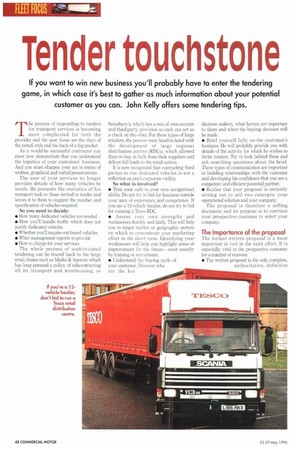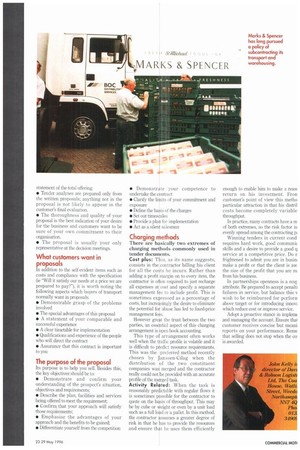Tender touchstone
Page 50

Page 51

If you've noticed an error in this article please click here to report it so we can fix it.
If you want to win new business you'll probably have to enter the tendering game, in which case it's best to gather as much information about your potential customer as you can. John Kelly offers some tendering tips.
The process of responding to tenders for transport services is becoming more complicated for both the provider and the user. Gone are the days of the pencil stub and the back of a fag packet.
As a would-be successful contractor you must now demonstrate that you understand the logistics of your customers' business. And you must sharpen your act in terms of written, graphical and verbal presentations.
The user of your services no longer provides details of how many vehicles he needs. He presents the statistics of his transport task to those invited to tender and leaves it to them to suggest the number and specification of vehicles required.
So you need to decide: • How many dedicated vehicles are needed • How you'll handle traffic which does not justify dedicated vehicles • Whether you'll require out-based vehicles • What management reports to provide • How to charge for your services The whole process of sophisticated tendering can be traced back to the large retail chains such as Marks & Spencer which has long pursued a policy of subcontracting all its transport and warehousing, or Sainsbury's, which has a mix of own.account and third-party provision so each can act as a check on the other. For these types of large retailers, the process went hand-in-hand with the development of large regional distribution centres (RDCs), which allowed them to buy in bulk from their suppliers and deliver full loads to the retail outlets.
It is now recognised that contracting third parties to run dedicated vehicles is not a reflection on one's corporate virility.
So what is involved?
• Trim your sails to your own navigational ability. Do not try to bid for business outside your area of experience and competence.. If you are a 15-vehicle haulier. do not try to hid for running a Tesco RDC.
• Assess your own strengths and weaknesses frankly and fairly. This will help you to target market or geographic sectors on which to concentrate your marketing effort in the short term. Identifying your weaknesses will help you highlight areas of improvement for the future—most usually by training or recruitment.
• Understand the buying cycle of your customer. Discover who are the key decision makers, what factors are important to them and when the buying decision will be made.
• Brief yourself fully on the customer's business. He will probably provide you with details of the activity for which he wishes to invite tenders. Try to look behind these and ask searching questions about the brief. These types of communication are important in building relationships with the customer and developing his confidence that you are a competent and efficient potential partner.
• Realise that your proposal is certainly setting out to sell two concepts: your operational solution and your company The proposal is therefore a selling document and its purpose is to convince your prospective customer to select your company.
The Importance of the proposal
The formal written proposal is a most important in tool in the sales effort. It is especially vital to the prospective customer for a number of reasons: • The written proposal is the only complete, authoritative, definitive statement of the total offering.
• Tender analyses are prepared only from the written proposals; anything not in the proposal is not likely to appear in the customer's final evaluation.
• The thoroughness and quality of your proposal is the best indication of your desire for the business and customers want to be sure of your own commitment to their organisation.
• The proposal is usually your only representative at the decision meetings.
What customers want in
rrproposals ion to the self-evident items such as costs and compliance with the specification fie "Will it satisfy our needs at a price we are prepared to pay?"), it is worth noting the following aspects which buyers of transport normally want in proposals.
• Demonstrable grasp of the problems involved • The special advantages of this proposal • A statement of your comparable and successful experience • A clear timetable for implementation • Qualifications and experience of the people who will direct the contract • Assurance that this contract is important to you
The purpose of the pro. 'sal
Its purpose is to help you sell. : --ides this, the key objectives should be to: • Demonstrate and confirm your understanding of the prospect's situation, objectives and requirements; • Describe the plan, facilities and services being offered to meet the requirement; • Confirm that your approach will satisfy those requirements; • Emphasise the advantages of your approach and the benefits to be gained; • Differentiate yourself from the competition • Demonstrate your competence to undertake the contract • Clarify the limits of your commitment and exposure • Define the basis of the charges • Set out timescales • Provide a plan for implementation • Act as a silent salesman
Charging methods
There are basically two extremes of charging methods commonly used in tender documents.
Cost plus: This, as its name suggests, consists in the contractor billing his client for all the costs he incurs. Rather than adding a profit margin on to every item, the contractor is often required to just recharge all expenses at cost and specify a separate management fee to include profit. This is sometimes expressed as a percentage of costs, but increasingly the desire to eliminate the potential for abuse has led to fixed-price management fees.
However great the trust between the two parties, an essential aspect of this charging arrangement is open book accounting.
This type of arrangement often works well when the traffic profile is volatile and it is difficult to predict resource requirements. This was the preferred method recently chosen by Janssen-Cilag when the distribution of the two constituent companies was merged and the contractor really could not be provided with an accurate profile of the merged task.
Activity Related: When the task is reasonably predictable with regular flows it is sometimes possible for the contractor to quote on the basis of throughput. This may be by cube or weight or even by a unit load such as a full load or a pallet. In this method, the contractor assumes a greater degree of risk in that he has to provide the resources and ensure that he uses them efficiently
enough to enable him to make a mast return on his investment. Fron customer's point of view this metho particular attraction in that his distril costs become completely variable throughput.
In practice, many contracts have a m of both extremes, so the risk factor is evenly spread among the contracting 11 Winning tenders in current cond requires hard work, good communic skills and a desire to provide a good q service at a competitive price. Do n frightened to admit you are in busini make a profit or that the client is aw the size of the profit that you are m from his business.
In partnerships openness is a resp attribute. Be prepared to accept penalti failures in service, but balance this v wish to be reimbursed for perforn above target or for introducing irmovl which reduce cost or improve service.
Adopt a proactive stance in implena and managing the account. Ensure thal customer receives concise but meani reports on your performance. Reme that selling does not stop when the co: is awarded.




















































































































